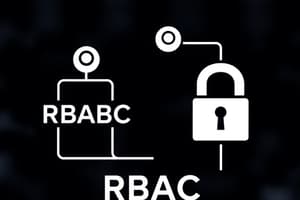Podcast
Questions and Answers
What is a primary function of Role-Based Access Control (RBAC) in vCenter?
What is a primary function of Role-Based Access Control (RBAC) in vCenter?
- Manage storage resources
- Directly implement virtual machines
- Define roles and delegate control (correct)
- Monitor external network traffic
Why is RBAC essential in virtualized environments?
Why is RBAC essential in virtualized environments?
- It prevents unauthorized access by limiting admin privileges. (correct)
- It allows unlimited access to all users.
- It automates the configuration of resources.
- It simplifies the user interface for all users.
How should roles be categorized in RBAC?
How should roles be categorized in RBAC?
- Randomly, to ensure equal access
- Based on geographical locations of users
- According to user preferences and requests
- By job responsibilities and specific tasks (correct)
What crucial aspect should be considered when defining permissions for roles in RBAC?
What crucial aspect should be considered when defining permissions for roles in RBAC?
Which statement is true regarding vCenter 8 and vSphere 5.2?
Which statement is true regarding vCenter 8 and vSphere 5.2?
What should be conducted regularly to maintain security in a vCenter environment?
What should be conducted regularly to maintain security in a vCenter environment?
What role may allow a user to only view data within vCenter?
What role may allow a user to only view data within vCenter?
What is an important aspect of monitoring usage patterns in a vCenter environment?
What is an important aspect of monitoring usage patterns in a vCenter environment?
Flashcards
RBAC
RBAC
Role-Based Access Control is a system used to manage access to resources in vCenter Server. It allows administrators to create different roles with specific privileges and assign these roles to users or groups.
vCenter 8 Compatibility
vCenter 8 Compatibility
vCenter Server 8 is incompatible with vSphere 5.2. You must use vSphere 7 or later for vCenter 8 to function.
RBAC Purpose
RBAC Purpose
RBAC aims to improve security by granting access to resources based on individual roles, rather than granting full access to everyone.
Role Definition
Role Definition
Signup and view all the flashcards
Role Assignment
Role Assignment
Signup and view all the flashcards
Importance of Role Permissions
Importance of Role Permissions
Signup and view all the flashcards
Security Audits
Security Audits
Signup and view all the flashcards
Proactive Security Management
Proactive Security Management
Signup and view all the flashcards
Study Notes
Configuring Role-Based Access Control (RBAC) to vCenter 8 in vSphere 5.2
- vCenter Server 8 and vSphere vCenter 5.2 are not compatible. vCenter 8 needs a vSphere 7 platform or later. Direct configuration between vCenter 8 and vSphere 5.2 is impossible. This means any configuration is theoretical and will not function directly.
- Role-based Access Control (RBAC) in vSphere is designed for granular access management in vCenter Server. It lets administrators define specific roles and delegate vCenter resource control to users/groups based on their needs.
- RBAC is critical for security in complex virtualized environments. Without it, a single administrator account has access to everything, creating a high security risk.
- vCenter 8 and vCenter 5.2 are not compatible, making direct RBAC setup impractical. Their functionalities, architecture, and roles differ.
- RBAC uses roles to dictate privileges for actions within vCenter. Examples include creating VMs, managing networks, powering off hosts.
- Roles are categorized for specific tasks like data center operations, application deployment, or security.
- Users/groups are assigned one or more roles. This controls access rights. An "Administrator" role provides full access; a "Read-Only" role limits access to viewing only.
- Precise role permissions are vital. Too many permissions are risky; too few limit efficiency.
- Configuring RBAC in vCenter 8 requires understanding specific needs and planned access levels.
- Security audits are needed to maintain access levels, detect discrepancies, and prevent unauthorized use. Monitoring critical resources (vCenter, datastores, VMs) is key for proactive security.
Studying That Suits You
Use AI to generate personalized quizzes and flashcards to suit your learning preferences.




